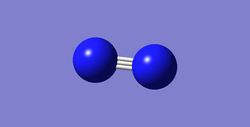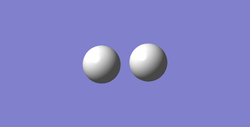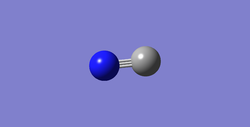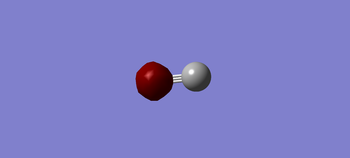Rep:Mod:sy4615
Ammonia
| NH3 | |
|---|---|
| r(E-X) | |
| θ(X-E-X) |
nh3 optimisation File Name SHYANT_NH3_OPTF_POP File Type .log Calculation Type FREQ Calculation Method RB3LYP Basis Set 6-31G(d,p) Charge 0 Spin Singlet E(RB3LYP) -56.55776873 a.u. RMS Gradient Norm 0.00000323 a.u. Imaginary Freq Dipole Moment 1.8465 Debye Point Group C3V Job cpu time: 0 days 0 hours 0 minutes 9.0 seconds.
test molecule |
The charge on the nitrogen atom in ammonia: -1.125 The charge on the hydrogen atom in ammonia: 0.375. The expected value for charge on nitrogen is about three times more than on hydrogen because the electronegative of nitrogen is also triple the value of hydrogen.
Basic summary for N2
Title Card Required File Name SHyant_n2_optf_pop File Type .log Calculation Type FREQ Calculation Method RB3LYP Basis Set 6-31G(d,p) Charge 0 Spin Singlet E(RB3LYP) -109.52412868 a.u. RMS Gradient Norm 0.00000060 a.u. Imaginary Freq 0 Dipole Moment 0.0000 Debye Point Group D*H Job cpu time: 0 days 0 hours 0 minutes 7.0 seconds.
The frequency is 2457.33.
Basic summary for H2
Title Card Required File Name SHyant_h2_optf_pop File Type .log Calculation Type FREQ Calculation Method RB3LYP Basis Set 6-31G(d,p) Charge 0 Spin Singlet E(RB3LYP) -1.17853936 a.u. RMS Gradient Norm 0.00000017 a.u. Imaginary Freq 0 Dipole Moment 0.0000 Debye Point Group D*H Job cpu time: 0 days 0 hours 0 minutes 6.0 seconds.
The frequency is 4465.68.
E(NH3)=-56.55776873 2*E(NH3)=-113.11553746 E(N2)=-109.52412868 E(H2)=-1.17853936 3*E(H2)=-3.53561808 ΔE=2*E(NH3)-[E(N2)+3*E(H2)]=-0.0557907
the energy for converting hydrogen and nitrogen gas into ammonia gas is -146.81 kj/mol. It is more stable in the ammonia form than in the reactant mixture.
Cyanide
test molecule |
Title Card Required File Name SHyantt_cn-_optf_pop File Type .log Calculation Type FREQ Calculation Method RB3LYP Basis Set 6-31G(d,p) Charge -1 Spin Singlet E(RB3LYP) -92.82453153 a.u. RMS Gradient Norm 0.00000704 a.u. Imaginary Freq 0 Dipole Moment 0.5236 Debye Point Group C*V Job cpu time: 0 days 0 hours 0 minutes 8.0 seconds.
The charge on the nitrogen atom in cyanide ion is -0.754 and the charge on the carbon atom is -0.246
This is the lowest energy sigma molecular orbital in the molecule, it is at at an energy well of -14.00393 au and are not very involved with chemical bonding.
These are the 3-sigma bonding MO and the 4-sigma anitibonding MO. They form by combining the 2s valence AOs in carbon and nitrogen atom. The energy of these orbitals are much more higher, therefore they are very involved in the chemical bonding.
These are the pi bonding orbitals, they have exactly the same energy of -0.01696 au,because there are two pi AOs on each atom that are perpendicular to the bond.
Formed by mixing of the 5 sigma and the 3 sigma MOs, the 5 sigma orbital goes up in energy and the become the HOMO in the molecules. The mixing also cause the distortion of the shape of the MOs.












